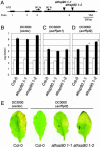HSP90 interacts with RAR1 and SGT1 and is essential for RPS2-mediated disease resistance in Arabidopsis
- PMID: 14504384
- PMCID: PMC208834
- DOI: 10.1073/pnas.2033934100
HSP90 interacts with RAR1 and SGT1 and is essential for RPS2-mediated disease resistance in Arabidopsis
Abstract
RAR1 and its interacting partner SGT1 play a central role in plant disease resistance triggered by a number of resistance (R) proteins. We identified cytosolic heat shock protein 90 (HSP90), a molecular chaperone, as another RAR1 interacting protein by yeast two-hybrid screening. RAR1 interacts with the N-terminal half of HSP90 that contains the ATPase domain. HSP90 also specifically interacts with SGT1 that contains a tetratricopeptide repeat motif and a domain with similarity to the cochaperone p23. In Arabidopsis, the HSP90 inhibitor geldanamycin reduces the hypersensitive response and abolishes resistance triggered by the R protein RPS2 against Pseudomonas syringae pv. tomato DC3000 (avrRpt2). One of four Arabidopsis cytosolic HSP90 isoforms, AtHSP90.1 is required for full RPS2 resistance and is rapidly induced upon pathogen challenge. We propose that RAR1 and SGT1 function closely with HSP90 in chaperoning roles that are essential for disease resistance.
Figures




Similar articles
-
Cytosolic HSP90 associates with and modulates the Arabidopsis RPM1 disease resistance protein.EMBO J. 2003 Nov 3;22(21):5679-89. doi: 10.1093/emboj/cdg547. EMBO J. 2003. PMID: 14592967 Free PMC article.
-
Structural and functional analysis of SGT1 reveals that its interaction with HSP90 is required for the accumulation of Rx, an R protein involved in plant immunity.Plant Cell. 2007 Nov;19(11):3791-804. doi: 10.1105/tpc.107.050427. Epub 2007 Nov 21. Plant Cell. 2007. PMID: 18032631 Free PMC article.
-
The RAR1 interactor SGT1, an essential component of R gene-triggered disease resistance.Science. 2002 Mar 15;295(5562):2073-6. doi: 10.1126/science.1067554. Epub 2002 Feb 14. Science. 2002. PMID: 11847307
-
The HSP90 complex of plants.Biochim Biophys Acta. 2012 Mar;1823(3):689-97. doi: 10.1016/j.bbamcr.2011.09.016. Epub 2011 Oct 6. Biochim Biophys Acta. 2012. PMID: 22001401 Review.
-
NLR sensors meet at the SGT1-HSP90 crossroad.Trends Biochem Sci. 2010 Apr;35(4):199-207. doi: 10.1016/j.tibs.2009.12.005. Epub 2010 Jan 22. Trends Biochem Sci. 2010. PMID: 20096590 Review.
Cited by
-
Differential gene expression in response to Papaya ringspot virus infection in Cucumis metuliferus using cDNA-amplified fragment length polymorphism analysis.PLoS One. 2013 Jul 9;8(7):e68749. doi: 10.1371/journal.pone.0068749. Print 2013. PLoS One. 2013. PMID: 23874746 Free PMC article.
-
From perception to activation: the molecular-genetic and biochemical landscape of disease resistance signaling in plants.Arabidopsis Book. 2010;8:e012. doi: 10.1199/tab.0124. Epub 2010 May 14. Arabidopsis Book. 2010. PMID: 22303251 Free PMC article.
-
Identification of the major protein components of rice egg cells.J Plant Res. 2007 Jul;120(4):575-9. doi: 10.1007/s10265-007-0095-y. Epub 2007 Jun 9. J Plant Res. 2007. PMID: 17558543
-
A putative nucleoporin 96 Is required for both basal defense and constitutive resistance responses mediated by suppressor of npr1-1,constitutive 1.Plant Cell. 2005 Apr;17(4):1306-16. doi: 10.1105/tpc.104.029926. Epub 2005 Mar 16. Plant Cell. 2005. PMID: 15772285 Free PMC article.
-
Interactome of signaling networks in wheat: the protein-protein interaction between TaRAR1 and TaSGT1.Mol Biol Rep. 2008 Sep;35(3):337-43. doi: 10.1007/s11033-007-9091-5. Epub 2007 Jun 13. Mol Biol Rep. 2008. PMID: 17564813
References
-
- Dangl, J. L. & Jones, J. D. G. (2001) Nature 411, 826–833. - PubMed
-
- Shirasu, K. & Schulze-Lefert, P. (2000) Plant Mol. Biol. 44, 371–385. - PubMed
-
- Staskawicz, B. J., Mudgett, M. B., Dangl, J. L. & Galan, J. E. (2001) Science 292, 2285–2289. - PubMed
-
- Shirasu, K., Lahaye, L., Tan, M.-W., Zhou, F., Azevedo, C. & Schulze-Lefert, P. (1999) Cell 99, 355–366. - PubMed
Publication types
MeSH terms
Substances
LinkOut - more resources
Full Text Sources
Other Literature Sources
Molecular Biology Databases
Miscellaneous

